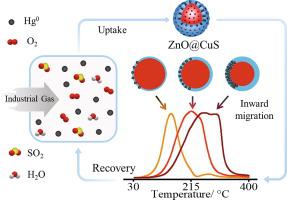Chemical Engineering Journal ( IF 13.3 ) Pub Date : 2020-11-03 , DOI: 10.1016/j.cej.2020.127592 Qinyuan Hong , Haomiao Xu , Jiaxing Li , Wenjun Huang , Ping Liu , Zan Qu , Naiqiang Yan

|
Inducing gaseous substances to migrate inward into a solid material is one of the effective methods to improve the interfacial adsorption stability. However, the gaseous mercury (Hg0) adsorption on bulk material, especially mineral sulfides, generally occurred on the outer surface owing to their compact structure, resulting in the low bonding stability. This study prepared porous ZnO@CuS with different shell thickness to investigate mercury adsorption performance and bonding stability. The porous shell structure enabled Hg0 to migrate inward into ZnO@CuS. Such an inducing effect, on one hand, improved the mercury adsorption performance due to the increase of active sites with the thickened shell. On the other hand, the mercury bonding stability was enhanced along with the increase of shell thickness. The initial mercury desorption temperature gradually increased from 50 to higher than 100 °C, and meanwhile, the desorption peak temperature increased from 150 to 275 °C. The improved bonding stability also enlarged its adaption to a wider temperature window (50–150 °C). Moreover, the optimal ZnO@CuS has a saturated adsorption capacity of 60.53 mg/g, and it has high resistance against O2, SO2, and H2O. This work thus offers a promising thickness-induced method to enhance the mercury bonding stability on sulfides.
中文翻译:

壳厚度引起的多孔ZnO @ CuS中汞的自发向内迁移,从而固定了气态汞
诱导气态物质向内迁移成固体物质是提高界面吸附稳定性的有效方法之一。然而,由于其致密结构,通常在外表面上发生在块状材料,尤其是矿物硫化物上的气态汞(Hg 0)吸附,从而导致低的结合稳定性。本研究制备了具有不同壳厚度的多孔ZnO @ CuS,以研究汞的吸附性能和键合稳定性。多孔壳结构使Hg 0向内迁移到ZnO @ CuS中。一方面,由于增加了外壳的活性位,增加了汞的吸附性能,从而提高了汞的吸附性能。另一方面,汞的结合稳定性随着壳厚度的增加而增强。最初的汞解吸温度从50℃逐渐升高到100℃以上,同时,解吸峰温度从150℃升高到275℃。改进的粘合稳定性还扩大了其对更宽温度范围(50–150°C)的适应性。此外,最佳的ZnO @ CuS的饱和吸附容量为60.53 mg / g,并且具有对O 2,SO 2和H 2的高耐受性。O.因此,这项工作提供了一种有希望的厚度诱导方法,以增强汞在硫化物上的键合稳定性。









































 京公网安备 11010802027423号
京公网安备 11010802027423号